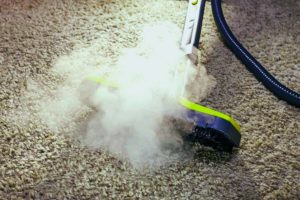Steam cleaning is undeniably the best, most efficient way to deep clean your carpets. Not only will you remove stains, odours and allergens, but also disinfect the whole surface.
You may think that steam cleaning is a big job and you need to hire a professional team to take care of it but in reality, it is not a difficult thing to do yourself. If you properly vacuum your carpet prior to cleaning it, the process will be very quick. The best part is that the results are always impressive.
What is steam cleaning?
Even though it is called steam cleaning, it doesn’t work with plain steam. In order to create steam, your water needs to reach 100°C. That temperature is enough to melt the adhesive that keeps your carpet fibres together. What is more, temperatures this high can also damage the surface of your carpet and even subflooring.
This is why professionals refer to this type of cleaning as the hot water extraction method, instead of steam cleaning. Cleaning companies offer it along the dry cleaning method. They are very different from each other.
We are happy to let you know that you can actually replicate the steam cleaning method at home and in this article we will show you exactly how in several steps.
Steps to steam clean your carpet
If you are worried about equipment, you can rent a carpet cleaning machine from your local hardware store. However, if you have a lot of carpeting, you may want to consider buying one. It is a great investment, since it will allow you to properly maintain your carpets in clean and fresh condition.
-
Clear the floor
Pick up everything that does not belong on the floor – toys, clothes, cushions etc. Move small furniture to another room. Make sure you have as much free space as possible. To protect the legs of heavy furniture you could not move, wrap them in aluminium foil.
-
Dust and vacuum thoroughly
Your carpet cleaner might get clogged if there is too much dirt, dust and pet hair. Make sure you dust your baseboards and thoroughly vacuum your whole carpet prior to steam cleaning. Do not miss the corners and also vacuum under any furniture that may still be in the room.
-
Pre-treat stains
Heat can, in fact, make some stain harder to remove. They might seem to disappear once you clean them, but reappear a couple of days later. The reason for that is the steam that forces the grime deeper into the carpet fibres. However, as they dry they push it back to the surface. It is best to pre-treat stains and darker areas prior to treating them with the hot water extraction method.
-
Fill the carpet cleaner’s water tank
Add hot (but not boiling water). Add one tablespoon of Castile soap for every quart of water. Make sure you follow the manufacturer’s instructions in order to avoid damage.
-
Work slowly, wall to wall
Most machines release a cleaning solution when pushed forward and extract it as you pull them back. Push the machine slowly so it can properly clean the surface, then pull it back as slowly, so it is able to extract as much water as possible. Make sure not to leave too much moisture behind, since it can cause mould and mildew growth.
-
Rinse with vinegar
Empty the water tank and refill it with a 1:1 mixture of distilled white vinegar and very hot water. This solution will help remove soap residue and kill allergens. Even more, it will dissolve oil, dirt and grime. You don’t need to rinse your carpet after this. Do not use apple cider vinegar.
-
Let it dry
If it is warm enough outside, you can open your windows to speed up the drying process. You can also run fans for a faster water extraction. You can place back your furniture after 8-12 hours (depending on the type of carpet that you have).
Some useful tips
-
It is best to deep clean your carpets at least once a year. Spring cleaning time is perfect for the job. If you have children or pets, you might need to clean them more often. Make sure to not overdo it since that may shorten your carpet’s lifespan.
-
Use castile soap for the cleaning mixture. If it is oil-based and is perfect for dissolving the oil based stains that can be found on your carpet.
-
Use this method to clean your upholstery as well. Make sure you check the fabric label for any specifics required for the cleaning of the piece.

